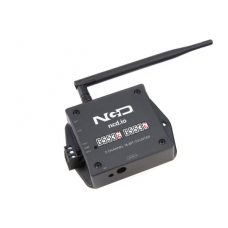IoT Long Range Wireless Two Channel Counter Transmitter
IoT Long Range Wireless Two Channel Counter Transmitter
Our long range wireless enterprise series sensors are an easy to use and reliable start to any data aggregation application. This video will demonstrate how they work, what they do, and how to use them.
IoT Long Range Wireless Two Channel Counter Transmitter
Introducing NCD’s Long Range IoT Wireless Two Channel Counter, boasting up to a 28 Mile range using a wireless mesh networking architecture. It incorporates two low latency counters that never miss a pulse even during sleep. This IoT Wireless Two Channel Counter device normally sleeps during no activity. If a pulse arrives at either input, it wakes up, counts it and if the number of pulses counted is a multiple of Counting Threshold then it sends a packets with the total number of pulses detected on both channels until then.
Afterwards it goes back to sleep. It also wakes up periodically after user defined delay and sends latest number of pulse counts on both channels. Thus with both functions it maximizes power efficiency.
Powered by just 2 AA batteries and an operational lifetime of 500,000 wireless transmissions, a 10 years battery life can be expected depending on environmental conditions and the data transmission interval. Optionally, this sensor may be externally powered.
With an open communication protocol this sensor can be integrated with just about any control system or gateway. Data can be transmitted to a PC, a Raspberry Pi, to Microsoft Azure® IoT, or Arduino. Sensor parameters and wireless transmission settings can be changed on the go using the open communication protocol providing maximum configurability depending on the intended application.
The long range, price, accuracy, battery life and security features of Long Range IoT Wireless Two Channel Counter with Reset makes it an affordable choice which exceeds the requirements for most of the industrial as well as consumer market applications.
Receiving Data From Long Range IoT Wireless Two Channel Counter Transmitter
This IoT Wireless Two Channel Counter device sends data periodically, based on user-preset timing intervals and on state change of the contact closure inputs. Data transmissions include battery level, signal strength, payload, firmware version, sensor type, and device serial number. Please see the Resources section to see detailed information on the data structure of this device. This wireless transmitter needs a receiver. There are many options available for receiving data from NCD transmitters. We highly recommend using our USB Modem (available during purchase) so you can monitor this device and use our LabVIEW software for changing device settings. Using our long-range USB wireless modem, users can expect easy operation over a virtual COM port at 115.2K baud. Optionally, we offer a Wireless receiver that operates over ethernet. Data from NCD sensors will appear over TCP/IP on port 2101. Simply open a TCP/IP socket, port 2101, to the IP address of the Ethernet modem and see your data stream in to your local area network. We take software samples seriously! Be sure to to check out the resources section of our web site to see code samples for Raspberry Pi, Visual Studio, LabVIEW, Arduino, Python, and more.
Now Supporting Microsoft Azure® IoT
We’ve been working with Microsoft engineers to post data from our sensors to Azure®. If you need help integrating this sensor into Azure®, please let us know and we will work with you to get you connected!

Applications:
- Number Of Pulse Counting
- Turnstile Counter
- Count The Number of Times A Door Open Closes
- To Count The Number Of Button Pushes
- IoT Digital Mechanical Counter
- Factory Automation
- Component of Low Power IoT System
- As a Mechanical Counter to IoT Cloud Interface Module

900HP-S3B Industrial Wireless Mesh
Long-Range Wireless Mesh networking is our favorite of all wireless communication technologies. This is the ONLY communications technology NCD recommends on the factory floor, operating at a safe 900MHz. Mesh technology will hop data from one location to another to reach its intended destination, users do not need to do anything other than make sure wireless modules stay within hopping range of each other. We use the Digi 900HP-S3B module in our products, as this is the best the industry has to offer. With a 2 mile range between modules and up to 8 hops, it is possible to cover 16 miles of wireless territory using this technology. Using high-gain antennas, this module is capable of communicating to a remote module up to 28 miles away.
Features
- Industrial Grade 2 Channel Counter
- 16 bit counters
- Minimum detectable pulse width 100 msec
- Highly Accurate Pulse Counting
- Low Latency Transmission
- Adjustable Counting Threshold for transmission (factory configurable)
- 2 Mile Range with On-Board Antenna
- Superior LOS Range of up to 28 miles with High-Gain Antennas
- Interface to Raspberry Pi, Microsoft Azure, Arduino and More
- Example Software for Visual Studio and LabVIEW
- Wireless Mesh Networking using DigiMesh®
- 256 Sensor Nod e per Network
- Open Communication Protocol for custom interfacing applications
- Small Form Factor Wireless Sensor (3×3 inch)
- Two modes of Operation
- Configuration mode for Sensor and X-bee Settings
- Factory Default Option using combination of hardware buttons
- Power efficient Built-in Sleep mode
- User Configurable Sleep duration
- Up to 500,000 Transmissions from 2 AA Batteries
- X-bee API mode use for reliable communication
- Improved reliability incorporating Re try feature in case of packet loss
- Real time battery status
Enter the code in the box below:





